Module 2 Unit 3 Traditional skills Grammar 课件 2022-2023学年牛津深圳版英语八年级下册 (共25张PPT)
文档属性
| 名称 | Module 2 Unit 3 Traditional skills Grammar 课件 2022-2023学年牛津深圳版英语八年级下册 (共25张PPT) | 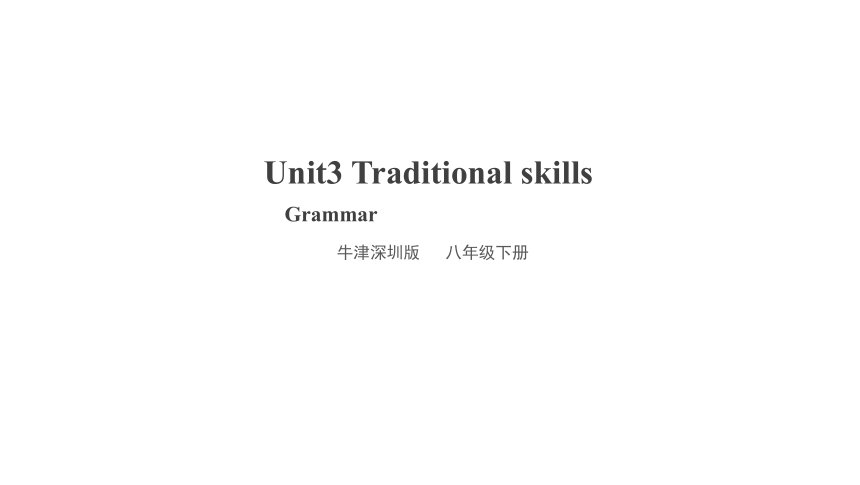 | |
| 格式 | pptx | ||
| 文件大小 | 23.6MB | ||
| 资源类型 | 教案 | ||
| 版本资源 | 牛津深圳版 | ||
| 科目 | 英语 | ||
| 更新时间 | 2023-11-04 18:58:29 | ||
图片预览

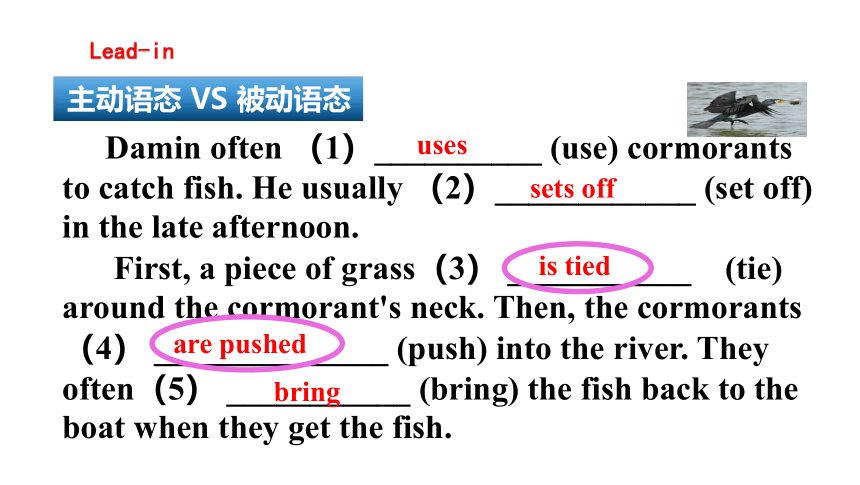
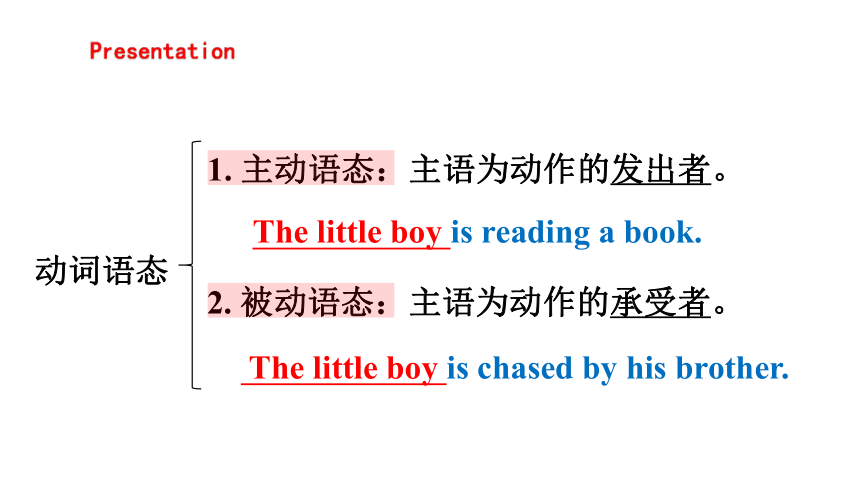



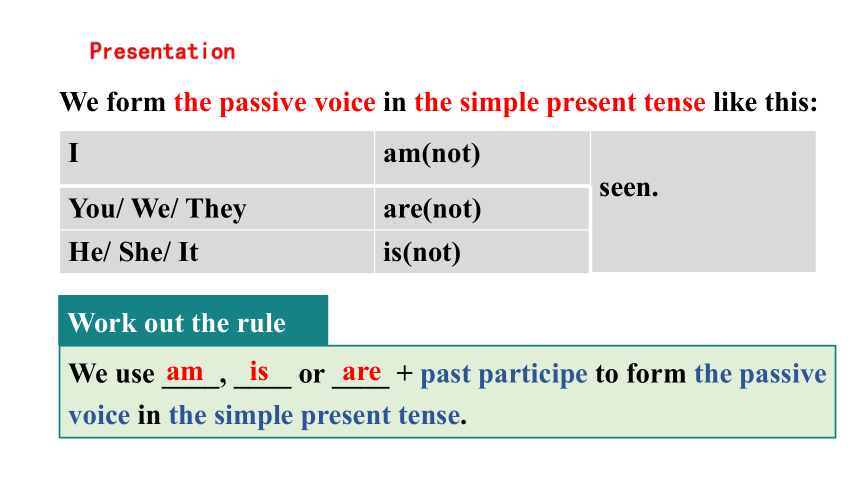
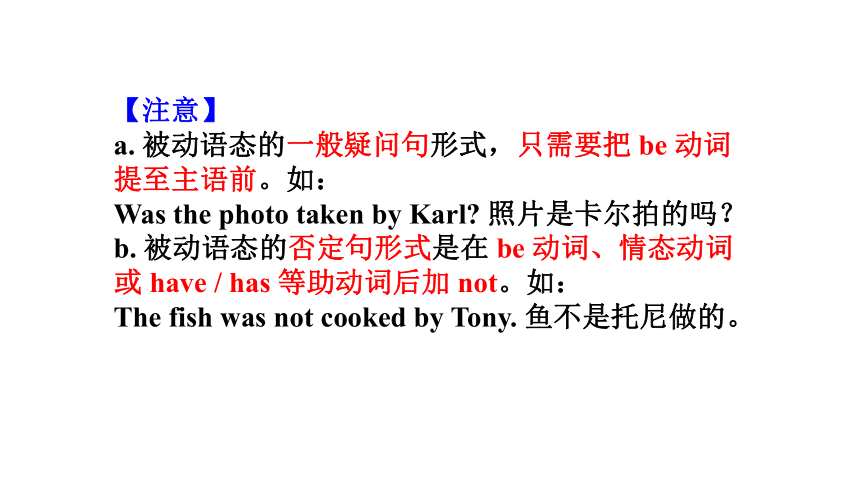
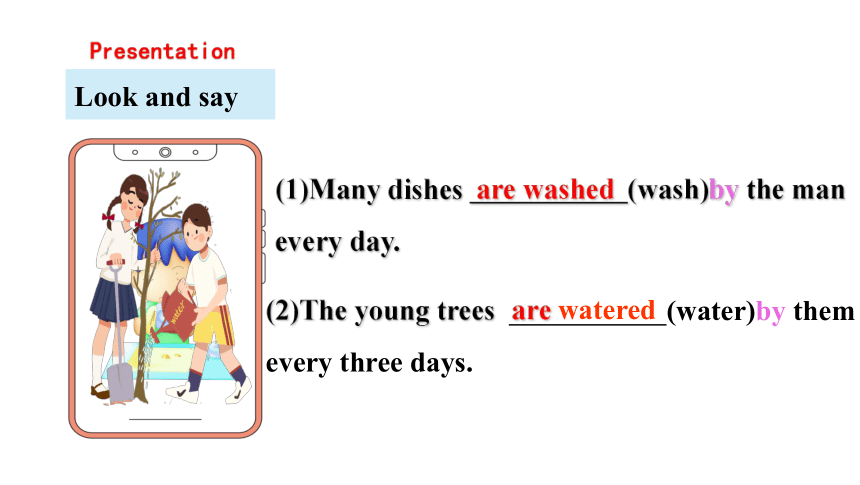
文档简介
(共25张PPT)
牛津深圳版 八年级下册
Unit3 Traditional skills
Grammar
Lead-in
Damin often (1)__________ (use) cormorants to catch fish. He usually (2)____________ (set off) in the late afternoon.
First, a piece of grass(3) ___________ (tie) around the cormorant's neck. Then, the cormorants(4) ______________ (push) into the river. They often(5) ___________ (bring) the fish back to the boat when they get the fish.
uses
sets off
is tied
are pushed
bring
主动语态 VS 被动语态
Presentation
2. 被动语态:主语为动作的承受者。
The little boy is chased by his brother.
1. 主动语态:主语为动作的发出者。
The little boy is reading a book.
动词语态
【总结】
(1)被动语态的构成由“______________________”构成。其用法如下:
a. 表示主语是动作的承受者,动作执行者一般由“________”引出。
b. 侧重说明主语接受动作,无需或无法知道动作的执行者是谁。
be+动词的过去分词
by
Presentation
被动语态的构成:
be +动词的过去分词
eg. The classroom is cleaned by the students every day.
学生们每天都打扫教室。
My bike was stolen last night.
我的自行车昨天被偷了。
A speech will be given this afternoon.
今天下午有一个演讲。
Presentation
Sometimes a cormorant sits on Damin’s head.
Damin sets off on his boat with his birds.
A piece of grass is tied around the neck of each bird.
At night, a light is hung on the post at the front of the boat.
The fish are then taken and thrown into a big basket.
Read the sentences below. Then decide whether the sentences are in the active form (A) or in the passive form (P).
(A)
(P)
(P)
(A)
(P)
Presentation
We form the passive voice in the simple present tense like this:
I am(not)
seen.
You/ We/ They are(not) He/ She/ It is(not) We use ____, ____ or ____ + past participe to form the passive
voice in the simple present tense.
Work out the rule
am
is
are
【注意】
a. 被动语态的一般疑问句形式,只需要把 be 动词提至主语前。如:
Was the photo taken by Karl 照片是卡尔拍的吗?
b. 被动语态的否定句形式是在 be 动词、情态动词或 have / has 等助动词后加 not。如:
The fish was not cooked by Tony. 鱼不是托尼做的。
Presentation
Look and say
(1)Many dishes (wash)by the man
every day.
are washed
(2)The young trees (water)by them
every three days.
are watered
A. Mary read another article about Damin and his birds in the plete the article with the verbs from the box in
the present passive form.
Presentation
Once a year, a new cormorant(1)_____________ by Damin. First, the cormorant eggs(2)_____________. Then the best one (3)__________ and given to a chicken. After 26 days, the baby cormorant breaks out of the egg.
bring up check control give look after take
is brought up
are checked
is taken
Then it (4)______________ by Damin himself. For ten days, it (5)__________ food every hour. The temperature (6)_____________ to keep the baby cormorant warm. The baby cormorant grows stronger. After two months, it can join the other cormorants on the boat.
bring up check control give look after take
is looked after
is given
is controlled
Presentation
Presentation
We form the passive voice in the simple past tense like this:
I was(not)
seen.
You/ We/ They were(not) He/ She/ It was(not) Work out the rule
We use _____ or _____ + past participe to form the passive
voice in the simple past tense.
was
were
B. Mary watched a TV programme about Damin. It was made by a film company from the UK. This is how they filmed the pleted the passage with the verbs from the box in the past passive form.
The film company wanted to make a programme about cormorant fishing, so we came from the UK to China. Many cormorant fishermen (1)__________________ .
choose film interview take use
were interviewed
Presentation
In the end, Damin (2)___________ because he is the best fisherman in his village. Then the camera and lights (3)__________ to Damin’s village. Damin (4)___________ by the cameraman. A boat (5)__________ to film on the river.
choose film interview take use
was chosen
were taken
was filmed
was used
Presentation
Presentation
Work out the rule
We form the passive voice in the simple future tense like this:
I will(not) be
seen.
You/ We/ They He/ She/ It We use _____ + past participe to form the passive voice
in the simple future tense.
will
Presentation
C. After the filming, the British director talked to Damin. Complete his words with the verbs from the box in the future passive form.
Thank you for your help, Damin. You did a wonderful job. Now the film (1)____________ back to the UK. We’ll do some more work on it. Some music (2)________________ to it.
add make show take watch
will be taken
will be added
Presentation
It (3)_____________ into a television programme. Then our programme (4)_____________ in many countries around the world. It (5)_________________ by millions of people!
add make show take watch
will be made
will be shown
will be watched
【观察】
1. Tourists are being shown around the places of interest.
游客们正被领着参观名胜古迹。
2. Modern buildings, roads, and parks are being built in this city.
这座城市正在修建现代化的建筑、道路和公园。
【思考】观察以上句子,例句中是什么时态的被动语态呢?
【总结】现在进行时的被动语态的结构为“am / is / are + ____________ +动词的过去分词”。
being
注意:
a. 只有及物动词才能用于被动语态,_________________ 不能用于被动语态。
b. 某些及物动词也很少用于被动语态。这些动词大多数是“静态动词”,即表示 ___________ 而不是动作的动词,如 cost, fit, have,lack 等。
例如:
Breakfast in this hotel costs 15 dollars.
这家酒店的早餐费用为 15 美元。
不及动物词
状态
Choose the correct answers:
( )1. The mobile phone has influenced people’s life a lot
since it_______ .
A. invents B. invented
C. is invented D. was invented
( )2. The sports meeting ________ next month.
A. will hold B. is going to hold C. will be held
( )3. Han Han’s books are popular. They______ by many
teenagers.
A. is read B. was read C. are read D. were read
D
C
C
Let's do
Summary
被动语态
(1)主动语态:主语是动作的发出者
被动语态:主语是动作的承受者
(2)结构:be + 及物动词的过去分词
一般现在时:am/ is/ are (not) + done
一般过去时: was/ were (not) + done
一般将来时:will (not) + be done
Fill in the blanks:
was invited
will be built
is made
wasn't read
will be finished
Exercise
1.I (invite)to go to Betty’s birthday last night. 2.A new shopping mall (build)here. It will be very convenient for us. 3.My breakfast (make)by my mother every day.4.The story (not read)by Granny yesterday.5.My homework (finish) in two hours.
【拓展】3
主动语态转换为被动语态
在将主动语态转换为被动语态的过程中,应注意以下几种结构不同的转换方式。
a. 主语 + 谓语 + 宾语
这类结构转换成被动语态时,把宾语转换成主语,主语转换为“by + 宾语”的短语,谓语动词转换为被动结构。如:
Susan bought the flowers just now.
→ The flowers were bought by Susan just now.
苏珊刚刚买了花。
b. 主语 + 谓语动词 + 间接宾语 + 直接宾语
这类结构转换时,既可将间接宾语转换成主语,
也可将直接宾语转换成主语。如:
Mr Green gave the children some cards.
→ Some cards were given to the children by Mr Green.
→ The children were given some cards by Mr Green.
格林先生给那些孩子一些卡片。
(1)He writes a letter to his parents every week.
变为被动句
被动句:A letter is written to his parents by him every week.
Rewrite sentences:
Exercise
(2)My cat ate my delicious fish yesterday.
变为被动句
被动句:My delicious fish was eaten by my cat yesterday.
(3)I will see the movie Kongfu Panda tomorrow.
变为被动句
被动句:The movie Kongfu Panda will be seen by me tomorrow.
牛津深圳版 八年级下册
Unit3 Traditional skills
Grammar
Lead-in
Damin often (1)__________ (use) cormorants to catch fish. He usually (2)____________ (set off) in the late afternoon.
First, a piece of grass(3) ___________ (tie) around the cormorant's neck. Then, the cormorants(4) ______________ (push) into the river. They often(5) ___________ (bring) the fish back to the boat when they get the fish.
uses
sets off
is tied
are pushed
bring
主动语态 VS 被动语态
Presentation
2. 被动语态:主语为动作的承受者。
The little boy is chased by his brother.
1. 主动语态:主语为动作的发出者。
The little boy is reading a book.
动词语态
【总结】
(1)被动语态的构成由“______________________”构成。其用法如下:
a. 表示主语是动作的承受者,动作执行者一般由“________”引出。
b. 侧重说明主语接受动作,无需或无法知道动作的执行者是谁。
be+动词的过去分词
by
Presentation
被动语态的构成:
be +动词的过去分词
eg. The classroom is cleaned by the students every day.
学生们每天都打扫教室。
My bike was stolen last night.
我的自行车昨天被偷了。
A speech will be given this afternoon.
今天下午有一个演讲。
Presentation
Sometimes a cormorant sits on Damin’s head.
Damin sets off on his boat with his birds.
A piece of grass is tied around the neck of each bird.
At night, a light is hung on the post at the front of the boat.
The fish are then taken and thrown into a big basket.
Read the sentences below. Then decide whether the sentences are in the active form (A) or in the passive form (P).
(A)
(P)
(P)
(A)
(P)
Presentation
We form the passive voice in the simple present tense like this:
I am(not)
seen.
You/ We/ They are(not) He/ She/ It is(not) We use ____, ____ or ____ + past participe to form the passive
voice in the simple present tense.
Work out the rule
am
is
are
【注意】
a. 被动语态的一般疑问句形式,只需要把 be 动词提至主语前。如:
Was the photo taken by Karl 照片是卡尔拍的吗?
b. 被动语态的否定句形式是在 be 动词、情态动词或 have / has 等助动词后加 not。如:
The fish was not cooked by Tony. 鱼不是托尼做的。
Presentation
Look and say
(1)Many dishes (wash)by the man
every day.
are washed
(2)The young trees (water)by them
every three days.
are watered
A. Mary read another article about Damin and his birds in the plete the article with the verbs from the box in
the present passive form.
Presentation
Once a year, a new cormorant(1)_____________ by Damin. First, the cormorant eggs(2)_____________. Then the best one (3)__________ and given to a chicken. After 26 days, the baby cormorant breaks out of the egg.
bring up check control give look after take
is brought up
are checked
is taken
Then it (4)______________ by Damin himself. For ten days, it (5)__________ food every hour. The temperature (6)_____________ to keep the baby cormorant warm. The baby cormorant grows stronger. After two months, it can join the other cormorants on the boat.
bring up check control give look after take
is looked after
is given
is controlled
Presentation
Presentation
We form the passive voice in the simple past tense like this:
I was(not)
seen.
You/ We/ They were(not) He/ She/ It was(not) Work out the rule
We use _____ or _____ + past participe to form the passive
voice in the simple past tense.
was
were
B. Mary watched a TV programme about Damin. It was made by a film company from the UK. This is how they filmed the pleted the passage with the verbs from the box in the past passive form.
The film company wanted to make a programme about cormorant fishing, so we came from the UK to China. Many cormorant fishermen (1)__________________ .
choose film interview take use
were interviewed
Presentation
In the end, Damin (2)___________ because he is the best fisherman in his village. Then the camera and lights (3)__________ to Damin’s village. Damin (4)___________ by the cameraman. A boat (5)__________ to film on the river.
choose film interview take use
was chosen
were taken
was filmed
was used
Presentation
Presentation
Work out the rule
We form the passive voice in the simple future tense like this:
I will(not) be
seen.
You/ We/ They He/ She/ It We use _____ + past participe to form the passive voice
in the simple future tense.
will
Presentation
C. After the filming, the British director talked to Damin. Complete his words with the verbs from the box in the future passive form.
Thank you for your help, Damin. You did a wonderful job. Now the film (1)____________ back to the UK. We’ll do some more work on it. Some music (2)________________ to it.
add make show take watch
will be taken
will be added
Presentation
It (3)_____________ into a television programme. Then our programme (4)_____________ in many countries around the world. It (5)_________________ by millions of people!
add make show take watch
will be made
will be shown
will be watched
【观察】
1. Tourists are being shown around the places of interest.
游客们正被领着参观名胜古迹。
2. Modern buildings, roads, and parks are being built in this city.
这座城市正在修建现代化的建筑、道路和公园。
【思考】观察以上句子,例句中是什么时态的被动语态呢?
【总结】现在进行时的被动语态的结构为“am / is / are + ____________ +动词的过去分词”。
being
注意:
a. 只有及物动词才能用于被动语态,_________________ 不能用于被动语态。
b. 某些及物动词也很少用于被动语态。这些动词大多数是“静态动词”,即表示 ___________ 而不是动作的动词,如 cost, fit, have,lack 等。
例如:
Breakfast in this hotel costs 15 dollars.
这家酒店的早餐费用为 15 美元。
不及动物词
状态
Choose the correct answers:
( )1. The mobile phone has influenced people’s life a lot
since it_______ .
A. invents B. invented
C. is invented D. was invented
( )2. The sports meeting ________ next month.
A. will hold B. is going to hold C. will be held
( )3. Han Han’s books are popular. They______ by many
teenagers.
A. is read B. was read C. are read D. were read
D
C
C
Let's do
Summary
被动语态
(1)主动语态:主语是动作的发出者
被动语态:主语是动作的承受者
(2)结构:be + 及物动词的过去分词
一般现在时:am/ is/ are (not) + done
一般过去时: was/ were (not) + done
一般将来时:will (not) + be done
Fill in the blanks:
was invited
will be built
is made
wasn't read
will be finished
Exercise
1.I (invite)to go to Betty’s birthday last night. 2.A new shopping mall (build)here. It will be very convenient for us. 3.My breakfast (make)by my mother every day.4.The story (not read)by Granny yesterday.5.My homework (finish) in two hours.
【拓展】3
主动语态转换为被动语态
在将主动语态转换为被动语态的过程中,应注意以下几种结构不同的转换方式。
a. 主语 + 谓语 + 宾语
这类结构转换成被动语态时,把宾语转换成主语,主语转换为“by + 宾语”的短语,谓语动词转换为被动结构。如:
Susan bought the flowers just now.
→ The flowers were bought by Susan just now.
苏珊刚刚买了花。
b. 主语 + 谓语动词 + 间接宾语 + 直接宾语
这类结构转换时,既可将间接宾语转换成主语,
也可将直接宾语转换成主语。如:
Mr Green gave the children some cards.
→ Some cards were given to the children by Mr Green.
→ The children were given some cards by Mr Green.
格林先生给那些孩子一些卡片。
(1)He writes a letter to his parents every week.
变为被动句
被动句:A letter is written to his parents by him every week.
Rewrite sentences:
Exercise
(2)My cat ate my delicious fish yesterday.
变为被动句
被动句:My delicious fish was eaten by my cat yesterday.
(3)I will see the movie Kongfu Panda tomorrow.
变为被动句
被动句:The movie Kongfu Panda will be seen by me tomorrow.
同课章节目录
